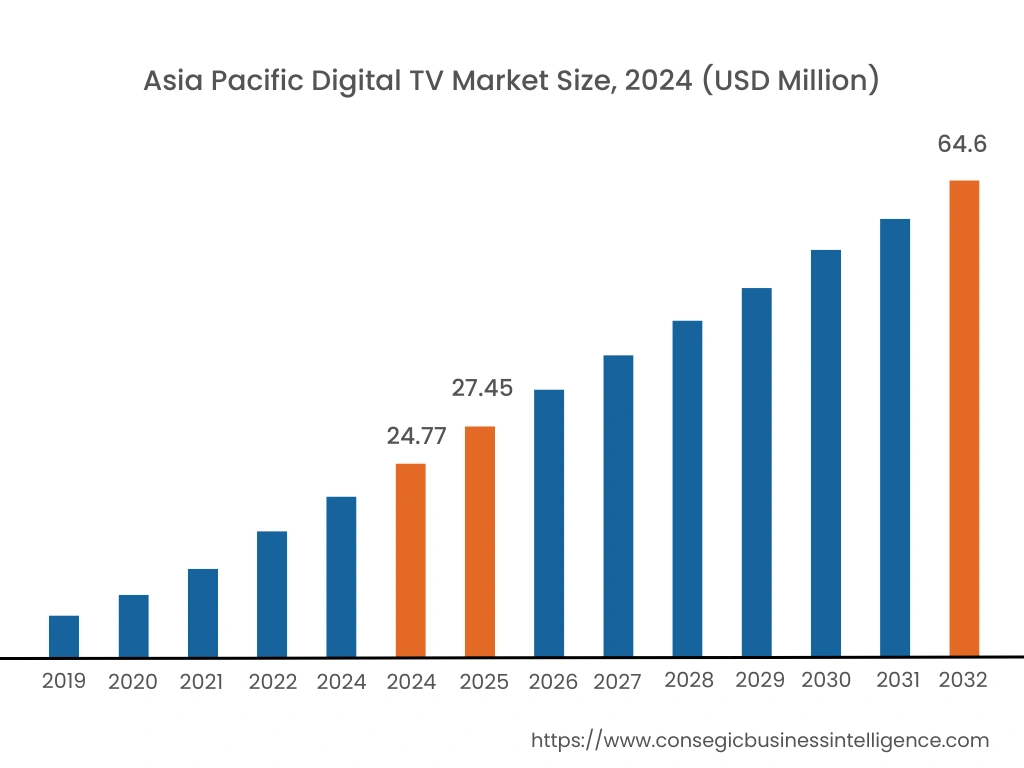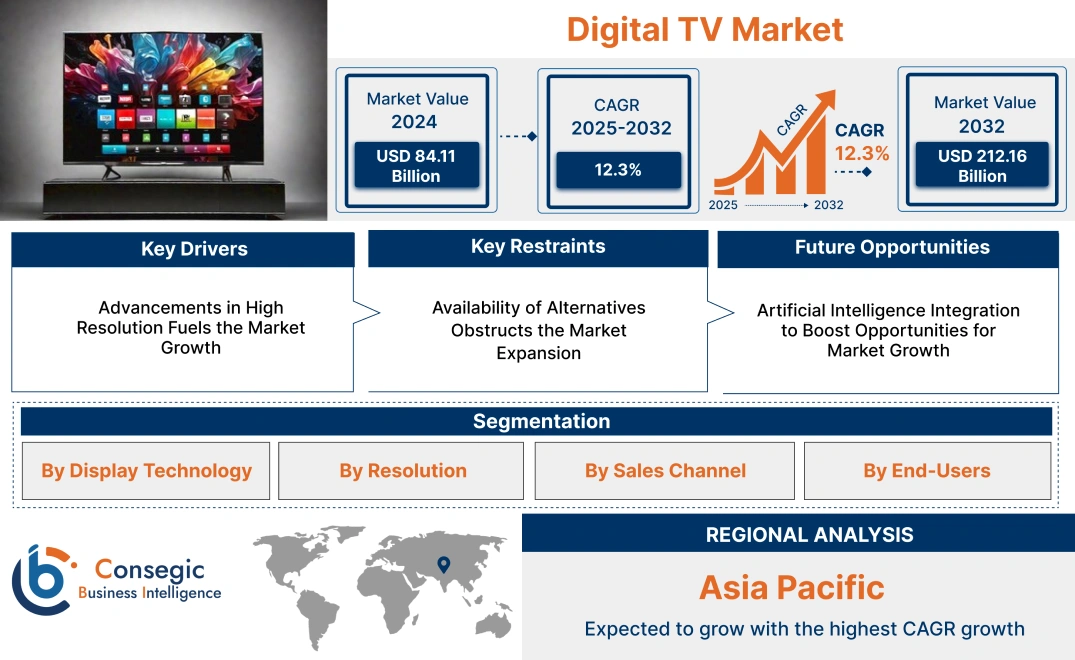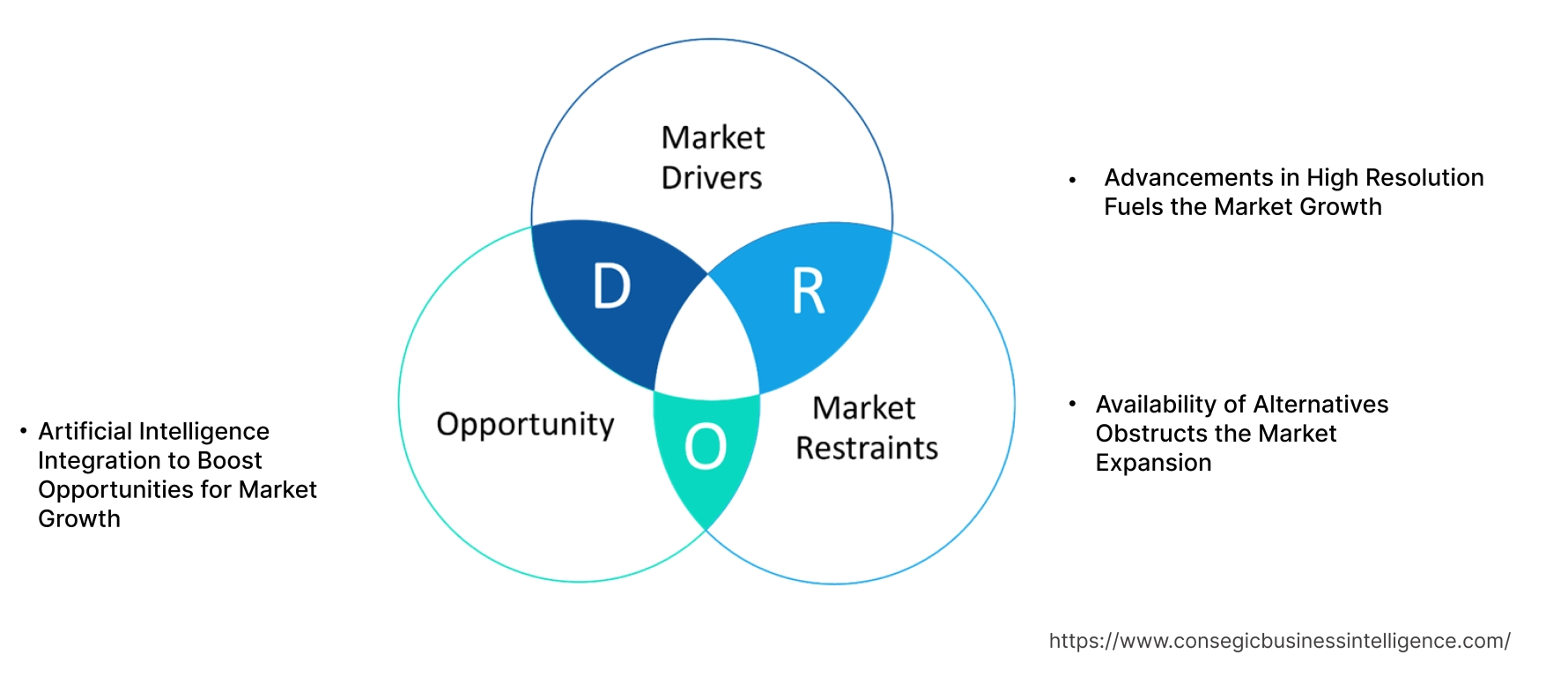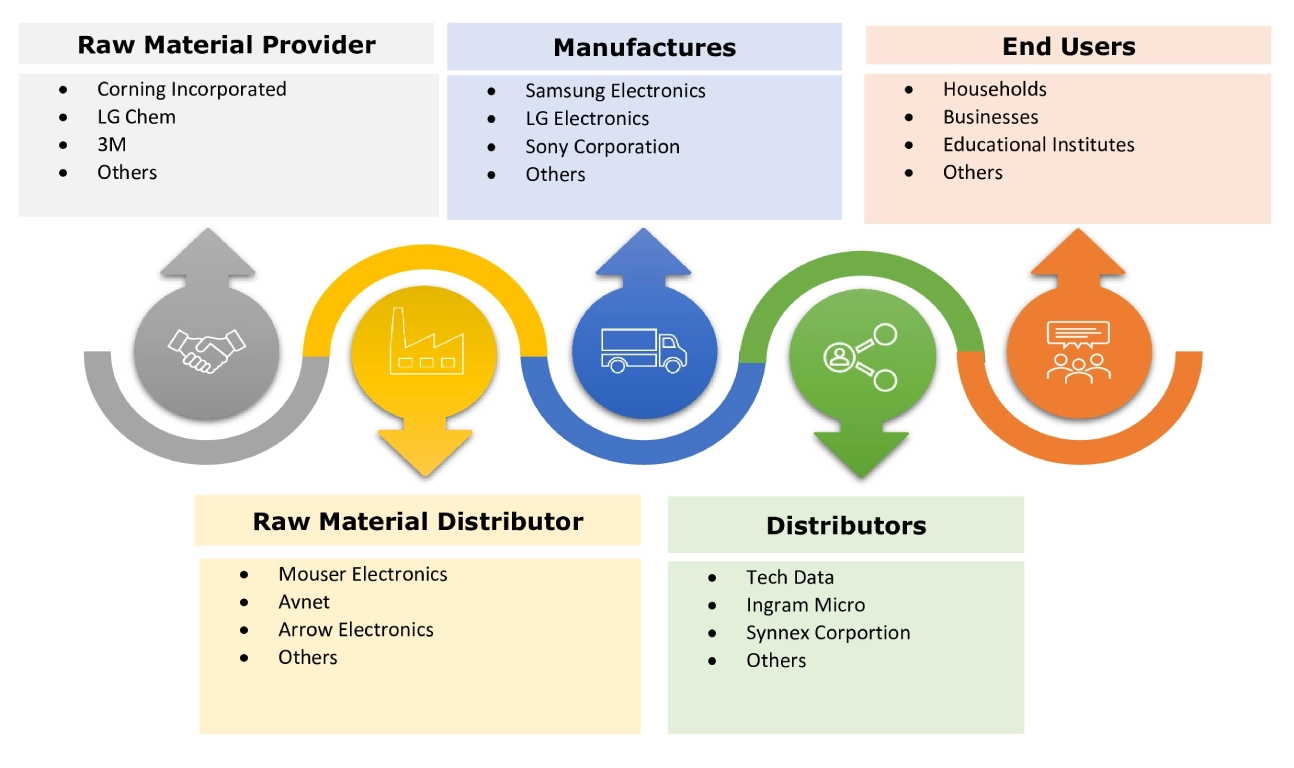- Summary
- Table Of Content
- Methodology
Digital TV Market Size:
Digital TV Market size is estimated to reach over USD 212.16 Billion by 2032 from a value of USD 84.11 Billion in 2024 and is projected to grow by USD 92.93 Billion in 2025, growing at a CAGR of 12.3% from 2025 to 2032.
Digital TV Market Scope & Overview:
Digital TV refers to a broadcasting technology that transmits television signals digitally, rather than using the analog signal to transmit video and audio. It uses digital compression to convert digital signals into digital packets of data, which are then transmitted over the air or via cable or satellite. These televisions provide superior picture quality by supporting high-definition (HD), ultra-high-definition (UHD), and advanced audio formats. Additionally, offers various benefits including multiple channels of programming on one frequency, digital video recording (DVR) capabilities, interactive features, electronic program guide (EPG), multiple audio tracks, and others. The aforementioned benefits of Digital TV are major determinants for increasing their deployment in households, commercial purposes, and others.
Digital TV Market Insights:
Key Drivers:
Advancements in High Resolution Fuels the Market Growth
High-resolution TVs particularly 4K and 8K models provide unparalleled picture clarity and detail, greatly enhancing the viewing experience. The increasing availability of high-resolution content from streaming services, broadcasters, and gaming platforms propels the demand. Additionally, factors including internet connectivity, streaming content, applications and services, interactive features, and voice and gesture control proliferate the market. This improvement in visual quality is a major draw for consumers seeking more immersive and enjoyable content.
- In October 2022, Apple launched the Apple TV 4K with enhanced power, entertainment, and affordability, showcasing stunning cinematic quality. It provides two options: the Apple TV 4K (Wi-Fi) with 64GB storage, and the Apple TV 4K (Wi-Fi + Ethernet) with Gigabit Ethernet support for quicker networking and streaming.
Therefore, as per analysis, the need for high-resolution televisions is driving the market.
Key Restraints :
Availability of Alternatives Obstructs the Market Expansion
There are multiple alternatives to Digital TV including Laptops, Smartphones, PCs, and Projectors, offering different ways to watch video content, potentially challenging the traditional market. Smartphones have become indispensable for their compact area and access to a wide array of streaming platforms and social media content, allowing users to stay connected and entertained on the move. Additionally, Laptops or PCs, with their larger screens and strong media features, act as multifunctional centers for both work and relaxation, effortlessly merging streaming services and platforms including Netflix, YouTube, and other OTT apps.
- In April 2021, Samsung launched a smart monitor with Ultra-High Definition (UHD) resolution enabling users to stream Netflix, YouTube, Apple TV, and other OTT apps remotely.
Hence, the availability of several alternatives that offer similar benefits with more convenience and flexibility than digital televisions is restraining the growth of the market.
Future Opportunities :
Artificial Intelligence Integration to Boost Opportunities for Market Growth
Artificial Intelligence can enhance viewer engagement through personalized content recommendations and improve content discovery with advanced algorithms. Additionally, AI-powered assistants like Amazon Alexa or Google Assistance, enable hands-free control of digital televisions enhancing convenience.
- In April 2024, Samsung introduced ultra-premium Neo QLED 8K, Neo QLED 4K, and OLED TVs with AI-powered solutions, to enhance viewer engagement by recommending personalized content along with 8K and 4K resolution.
Thus, the integration of Artificial Intelligence is anticipated to increase the adoption of television to attain personalized content and AI-powered assistance, in turn promoting the Digital TV market growth demand during the forecast period.
Digital TV Market Segmental Analysis :
By Display Technology:
Based on display technology the market is segmented into LED, LCD, OLED, and others.
Trends in the display technology:
- Quantum dots are increasingly being utilized in televisions for better color accuracy along with energy efficiency and longer lifespan, enhancing the viewing experience.
- Advancements such as interactive displays and touchscreens allow for multi-touch functionality, improving usability and interactivity.
The LED segment accounted for the largest revenue share in 2024.
- LED (Light-emitting diode) display technology is widely adopted in television screens due to the balance of performance, price, and availability.
- Factors include enhanced brightness, high dynamic range (HDR), and high resolution for detailed and sharp images.
- In September 2021, Sony introduced the BRAVIA XR MASTER Series 85Z9J television powered by the Cognitive Processor XR. The 8K resolution LED TV provides sheer brilliant picture with defined details of High Dynamic Range (HDR), exceptional clarity brightness, and color.
- Therefore, the high-resolution and dynamic range provided by LED displays is boosting the digital TV industry.
The OLED is anticipated to register the fastest CAGR during the forecast period.
- OLED (Organic light-emitting diode) is a display technology that uses LEDs in which light is produced by organic molecules.
- The OLED TVs enable emissive displays which implies that each pixel is controlled individually and emits light.
- Features of an OLED display include great image quality, true black, bright colors, fast motion, and infinite contrast ratios.
- In June 2023, Samsung released an OLED TV range with a Neural Quantum Processor 4K resolution that delivers deep black, vibrant colors, incredible detail, and unbelievable screen brightness.
- Thus, as per analysis, the demand for OLED TV is anticipated to grow in digital TV market opportunities in the forecast period.
By Resolution:
Based on resolution the market is segmented into 720p, 1080p, 4K, 8K, and others.
Trends in the resolution:
- Streaming services offer content in 1080p (Full HD), making it a viable option for consumers who primarily use TVs for streaming movies and shows.
- Advanced scaling technologies and upscaling features including AI improve the clarity and quality of lower-quality content on high-resolution display.
The 4K segment accounted for the largest revenue share in the year 2024.
- 4K TVs provide four times the pixel counts of full HD; it is also known as Ultra High-Definition (UHD).
- These resolutions offer a range of benefits including enhanced picture quality, better viewing angles, and improved color accuracy.
- In August 2023, LG Electronics launched an OLED TV 97-inch LG SIGNATURE OLED M with 4K resolution (3,840 x 2,160 pixels) and 120Hz refresh rate providing enhanced picture quality.
- Hence, the analysis concludes that these features of 4K resolution are collectively propelling the digital TV market trend.
The 8K is anticipated to register the fastest CAGR during the forecast period.
- The 8K resolution refers to a display resolution of 7680x4320 pixels, which is four times the 4K resolution.
- The primary benefits of 8K resolution include exceptional clarity, better large-screen performance, and improved texture and depth.
- Additionally, OTT platforms are creating 8K content in collaboration with key players in digital televisions.
- In August 2022, Samsung Electronics partnered with Prime Video to offer series content in 8K resolution on Neo QLED 8K TVs and "The Wall" 8K Micro LED displays.
- Therefore, the adoption of 8K content on television is anticipated to drive the global digital TV market demand.
By Sales Channel:
Based on sales channel the market is segmented into Retail, Online, and others.
Trends in the sales channel:
- Influencer partnerships and affiliate marketing programs are driving online sales, with gamers turning to trusted personalities for recommendations on the latest accessories.
- Adoption of omnichannel retail strategies where brands integrate digital and offline sales channels seamlessly, providing customers with flexible purchasing options and consistent brand experience.
The retail segment accounted for the largest revenue share of 47.93% in the year 2024.
- Retail stores provide customers with the opportunity to see and experience TV, due to this tactile experience enhances the shopping experience.
- These stores offer in-store promotions, discounts, and deals to attract customers. The promotions include extended warranties, free installation, or additional accessories, providing added value.
- Hence, as per the analysis retail stores segment is boosting the digital TV market growth.
The online segment is anticipated to register the fastest CAGR during the forecast period.
- The increasing expansion of E-commerce platforms is enabling consumers and businesses to research, compare, and purchase systems remotely with ease.
- Factors including convenience and accessibility, price comparisons and discounts, customization, product availability, and global reach are key aspects driving the expansion of the online segment.
- According to the analysis of the International Trade Administration, India is anticipated to see a significant increase in e-commerce revenue, going from USD 46.2 billion in 2020 to USD 136.47 billion by 2026, making it the fastest-growing e-commerce market globally.
- Therefore, the trend suggests that online sales channel is expected to grow the global digital TV Market demand.

By End User:
Based on End-User the market is segmented into Households, Businesses, Gamers, Educational institutes, and others.
Trends in the end-users:
- Businesses are adopting digital televisions for digital signage to enhance customer engagement and communication in retail, hospitability, and corporate environments.
- Educational institutes are incorporating interactive television displays in classrooms to enhance learning experiences through multimedia content and interactive lessons.
The household segment accounted for the largest revenue share in the year 2024.
- Households are increasingly adopting smart digital TVs with built-in internet connectivity and online streaming apps.
- This trend is driven by the convenience of accessing OTT content from platforms including Netflix, Amazon Prime, Hulu, and Disney+ directly on televisions
- In April 2023, LG Electronics, joined forces with Prime Video for the new series "Citadel" available on LG Smart TVs, providing better visuals with an OLED display, vibrant colors, and a high frame rate.
- Consequently, the rising demand for OTT content on televisions in households necessitates high-resolution displays, fueling the digital TV market trend.
The gamers segment is anticipated to register the fastest CAGR during the forecast period.
- Gamers prefer TV with a high refresh rate, low input lag, and game bar to ensure smoother and more responsive gameplay.
- Additionally, the surging need for online gaming hubs included in televisions without requiring extra accessories provides an optimal gaming experience.
- In July 2022, Samsung Electronics revealed that the Samsung Gaming Hub1 is available on all 2022 Samsung Smart TVs providing top-notch game streaming content and gaming experiences without requiring any extra hardware or downloads. Samsung Gaming Hub is a comprehensive platform for game streaming discovery where players can explore and enjoy games from partners like Xbox, NVIDIA GeForce NOW, Google Stadia, Utomik, and soon Amazon Luna. The Samsung Gaming Hub provides improved, quicker, and easier entry to gaming content on Samsung TVs, such as the 2022 Neo QLED 8K, Neo QLED 4K, and QLEDs.
- Thus, the expansion of the Gamers segment is attributed to several factors including the rising popularity of online games, streaming content, and technological advancement, proliferating the digital TV market opportunities.
Regional Analysis:
The regions covered are North America, Europe, Asia Pacific, Middle East and Africa, and Latin America.

Asia Pacific region was valued at USD 24.77 Billion in 2024. Moreover, it is projected to grow by USD 27.45 Billion in 2025 and reach over USD 64.6 Billion by 2032. Out of this, China accounted for the maximum revenue share of 36.9%. As per the Digital TV market analysis, the Asia Pacific region is experiencing rapid expansion in the digital TV market, driven by increasing digitalization and technological advancements. Countries including China, Japan, South Korea, and India are significant contributors to the market with leading manufacturers of televisions. Moreover, the investment of these countries in consumer electronics is expected to propel the digital TV market share.
- According to the Gateway House of the Indian Council, China has invested $4 billion in Indian start-ups, with 18 out of 30 unicorns having Chinese backing. This achievement can be attributed to the lack of significant Indian venture investors, China's long-term investment approach, and the strategic importance of the Indian market for firms such as Alibaba and Tencent. Western funds for ventures take into account various investment considerations.

North America is estimated to reach over USD 68.76 Billion by 2032 from a value of USD 27.9 Billion in 2024 and is projected to grow by USD 30.77 Billion in 2025. The region is categorized by early adoption of new technologies including high-resolutions and smart TV features. Additionally, streaming services including Netflix, Hulu, and Disney+ have a strong presence in proliferating the digital TV market.
- In April 2021, Apple launched Apple TV 4K delivering high frame rate HDR with Dolby Vision and enabling customers to access personalized content with the highest quality. Additionally, the Siri Remote offers to stream shows and movies on Apple TV with intuitive navigation controls.
Europe is another key market for Digital TV, with major countries including the UK, Germany, and France leading in its adoption. The region shows a strong preference for advanced display technologies including OLED and QLED, along with high-resolution formats. Additionally, the trend towards smart homes is also prominent with consumers integrating smart TVs into home automation systems.
Latin America presents a growing digital TV market driven by increasing consumer spending on home entertainment. The market is characterized by strong demand for affordable 4K TVs, as consumers seek to upgrade their viewing experience.
The Middle East and Africa region demonstrate steady growth in the digital TV market, with significant potential for future expansion. Advanced entertainment technologies are among the major aspects for expansion of the market dominated by countries including UAE and Saudi Arabia.
Top Key Players & Market Share Insights:
The Digital TV market is highly competitive with major players providing improved picture quality to the national and international markets. Key players are adopting several strategies in research and development (R&D), product innovation, and end-user launches to hold a strong position in the digital TV market. Key players in the digital TV industry include-
- Samsung Electronics(South Korea)
- LG Electronics (Japan)
- Panasonic Corporation (Japan)
- Apple Inc (US)
- Toshiba Corporation (Japan)
- Sony Corporation (Japan)
- Hisense (China)
- Haier (China)
- PHILIPS (Netherlands)
- Xiaomi (China)
Recent Industry Developments :
Product Launches:
- In May 2024, Sony introduced the BRAVIA 2 series with Google TV, showcasing 4K Ultra HD LED display technology to enhance the entertainment experience. Combined with Google TV, individuals can easily reach a variety of applications, streaming platforms, and live television channels tailored to their preferences.
- In April 2023, Samsung introduced a range of Neo QLED 8K, Samsung OLED, Lifestyle TVs, and sound devices, delivering stunning picture quality with an Infinity design that eliminates bezels and borders, creating a seamless 8K viewing experience. Industry experts and reviewers are equally impressed by the QN900C due to innovative features such as Auto HDR Remastering and 8K AI upscaling.
Announcement:
- In July 2024, LG Electronics announced that it is releasing the OLED EVO M4 series TV worldwide, complete with the Zero Connect Box for wireless communication between the TV and the receiver. Driven by the advanced LG α (Alpha) 11 AI Processor, the OLED M4 offers top-notch home entertainment and introduces fresh openings in living-space arrangement with its exclusive wireless-transmission technology.
Collaboration:
- In December 2023, LG Electronics partnered with Netflix to integrate the Netflix entertainment experience into webOS for Automotive, LG's automotive content platform, and LG smart TV. The shift demonstrates LG's continuous growth as a media and entertainment company and provides a seamless content experience.
Digital TV Market Report Insights :
| Report Attributes | Report Details |
| Study Timeline | 2019-2032 |
| Market Size in 2032 | USD 212.16 Billion |
| CAGR (2025-2032) | 12.3% |
| By Treatment |
|
| By Resolution |
|
| By Sales Channel |
|
| By End-User |
|
| By Region |
|
| Key Players |
|
| North America | U.S. Canada Mexico |
| Europe | U.K. Germany France Spain Italy Russia Benelux Rest of Europe |
| APAC | China South Korea Japan India Australia ASEAN Rest of Asia-Pacific |
| Middle East and Africa | GCC Turkey South Africa Rest of MEA |
| LATAM | Brazil Argentina Chile Rest of LATAM |
| Report Coverage |
|
Key Questions Answered in the Report
What is Digital TV? +
Digital TV refers to a broadcasting technology that transmits television signals digitally, rather than using analog method. It uses digital compression to convert digital signals into digital packets of data, which are then transmitted over the air or via cable or satellite. These televisions provide superior picture quality by supporting high-definition (HD), ultra-high-definition (UHD), and advanced audio formats.
How big is the Digital TV market? +
Digital TV Market size is estimated to reach over USD 212.16 Billion by 2032 from a value of USD 84.11 Billion in 2024 and is projected to grow by USD 92.93 Billion in 2025, growing at a CAGR of 12.3% from 2025 to 2032.
What is the key market trend? +
Quantum dots are increasingly being utilized in televisions for better color accuracy along with energy efficiency and longer lifespan, enhancing the viewing experience.
Who are the major players in the digital TV market? +
The key players in digital TV are Samsung Electronics (South Korea), LG Electronics (Japan), Sony Corporation (Japan), Panasonic Corporation (Japan), Apple Inc (US), Hisense (China), Haier (China), PHILIPS (Netherlands), Toshiba Corporation (Japan), Xiaomi (China) and others



